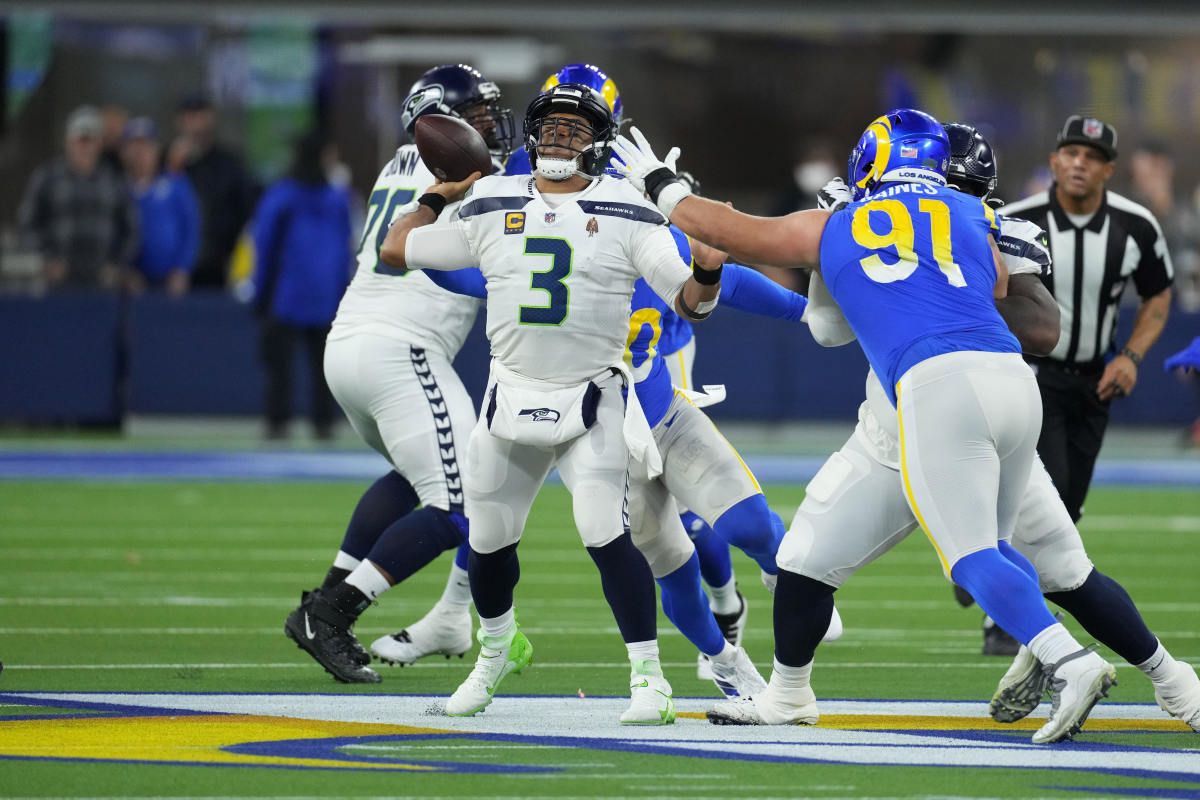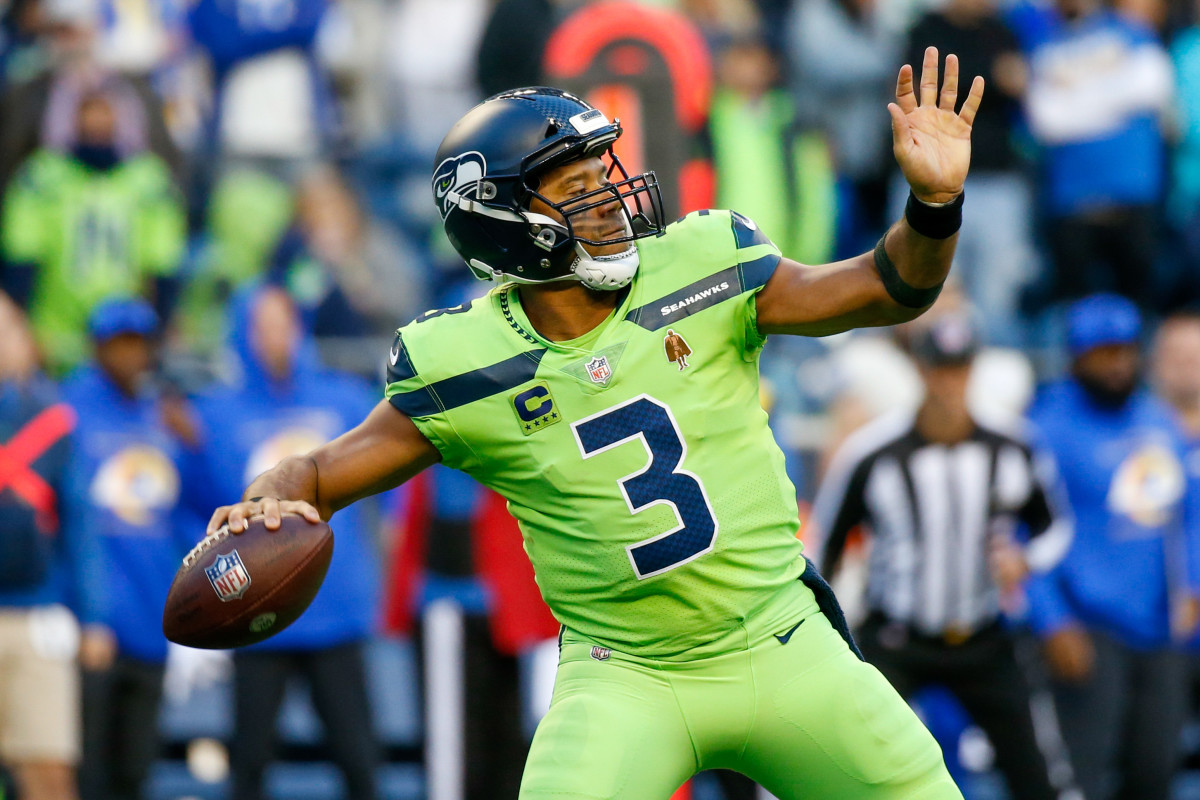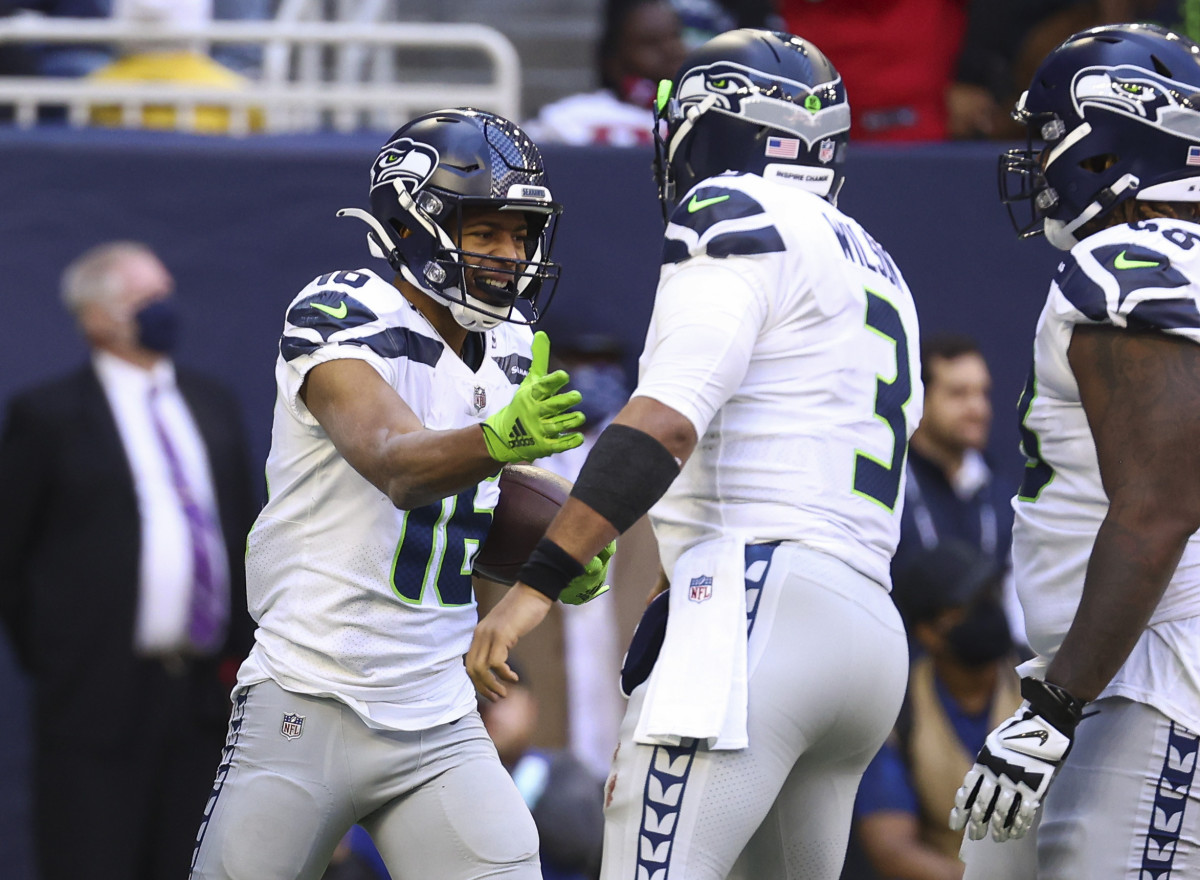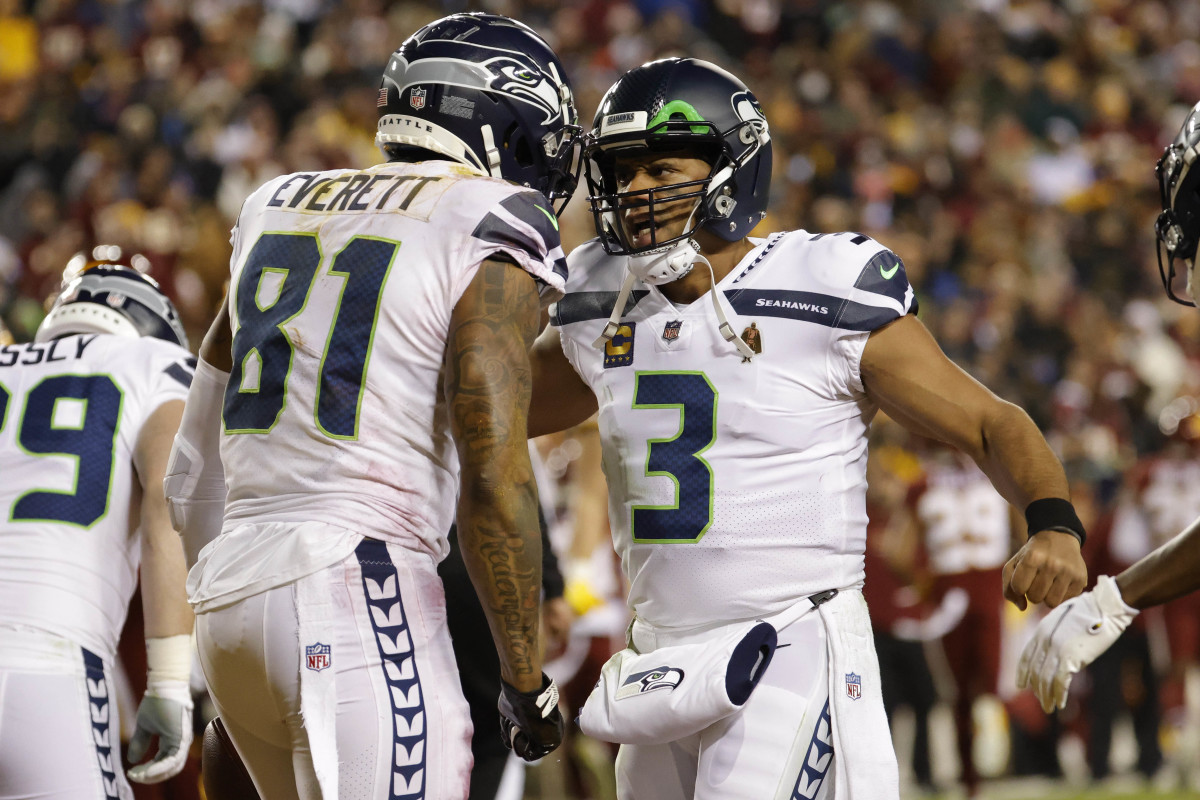Analysis: What Russell Wilson, Seahawks Must Accomplish to Improve Third Down Efficiency
Not much went according to plan for coach Pete Carroll and the Seahawks in 2021, as the defending NFC West champions scuffled to a 7-10 finish and missed the playoffs for the first time in five years.
Struggling to explain Seattle's unexpected struggles as a dreadful season unfolded, Carroll kept coming back to third down struggles and inability to sustain drives on offense, seemingly grasping for straws trying to find answers to the problem. For most of the season, the team ranked near the bottom of the league in third down conversion rate, residing alongside not-so-welcome company with Detroit, Chicago, and Jacksonville, three of the worst offenses in the sport.
Several factors helped create this issue for the Seahawks, starting with quarterback Russell Wilson suffering a ruptured tendon in his right middle finger in a Week 5 loss to the Rams. He wound up missing three games and wasn't his usual self upon his return to the lineup, finishing 28th in the league in completion percentage on third down. An inconsistent offensive line and learning a new system under first-time coordinator Shane Waldron also contributed to the year-long third down woes.
Looking back at the 2021 campaign, nothing may have grounded Seattle's playoff chances more than the atrocious third down play by Wilson and his counterparts. What must be accomplished in order to get the offense back on track and improve third down efficiency?
Supplemented by stats courtesy of TruMedia, here's a six-step blueprint to ensure the Seahawks don't deal with the same concerns in 2022.
1. Wilson must be more accurate, particularly in third-and-medium situations

Historically, Wilson's completion rates have taken a substantial dip on third down, dropping from 65 percent on first and second down to 59 percent on third down. To an extent, that shouldn't be an unexpected development. When needing five or more yards to move the chains, opposing pass rushers can pin their ears back and tee off on quarterbacks, which makes it far tougher to hang in the pocket and complete passes. There's a reason why the completion rate league-wide dropped from 67 percent on first and second down to 60 percent on third down last season.
But even by Wilson's standards, the contrasts between his first and second down completion rates compared to third down were shocking in 2021. He ranked sixth in the NFL with a 70.2 percent completion rate on first and second down, which helped contribute to his second-ranked passer rating among 31 qualified quarterbacks. On third downs, however, that percentage plunged nearly 20 percent to 51.5 percent, which ranked 28th ahead of only Justin Fields, Trevor Lawrence, and Baker Mayfield. His 18.7 percent decline from early downs to third down ranked a distant first ahead of Mayfield (14.3 percent).
What's even more startling? Wilson's struggles on third down were especially problematic in favorable situations where Seattle needed five or fewer yards to pick up a new set of downs. He ranked dead last in the NFL completing just 46.2 percent of his passes in 3rd and 2 to 3rd and 5 scenarios and picked up a first down via the pass on just 16 out of 44 drop backs.
Looking at the film, Wilson's finger injury seemed to impact his accuracy more than anything. In his first three games back from surgery, he completed just nine out of 22 pass attempts on third down for 121 yards and moved the chains on just eight out of 30 drop backs. While he wouldn't admit it at the time, playing with a finger at less than 100 percent caused him to consistently airmail or misfire on slants, curls, and other short routes that could have moved the chains.
If a fully healthy Russell Wilson can't consistently complete third down passes like this errant curl to Gerald Everett in 2022, then the Seahawks have a major conundrum on their hands.
— Corbin K. Smith (@CorbinSmithNFL) February 3, 2022
Not hard to see why third down numbers were so abysmal with misses like this one. pic.twitter.com/A3Bm5rn0A4
With his finger fully healed next season, Wilson will need to complete passes like this poorly thrown third down curl route to Gerald Everett for the Seahawks to help sustain drives. If he can't connect on those types of elementary passes on a consistent basis, then that's a huge problem for their offense moving forward. But the good news is that as his health improved, his numbers improved down the stretch with a 62 percent completion rate on third down in Seattle's last six games, suggesting that shouldn't be an issue.
2. Wilson and the Seahawks must be less reliant on go balls and utilize more diversified third down route distribution

Few quarterbacks come close to stacking up with Wilson when it comes to completing the deep ball. Dating back to his rookie season, on pass plays of 20 or more air yards, he ranks first in completions (282), first in touchdown passes (81), and first in total passing yards (9,948). He also ranks first in the NFL during that span with 19 touchdown passes of 40 or more air yards, further illustrating his proficiency lofting beautiful spirals to his receivers downfield.
Despite Wilson's gaudy numbers, however, his propensity for taking low percentage deep shots can be a detriment to Seattle's offense. Last season, Wilson attempted 103 passes on third down and per Pro Football Focus, 22 of those attempts were targeting go routes (21.3 percent). He connected on only nine of those passes for a 40.9 percent completion rate, but he did throw four touchdowns, including a 68-yard bomb to Freddie Swain in a Week 2 loss to Tennessee.
Such a feast or famine approach can put points on the board in a hurry as demonstrated by Swain's long score against busted coverage. But throwing go routes on nearly a quarter of third down pass attempts isn't going to lead to an efficient offense that consistently sustains drives. Once the explosives start to dry up and opponents take away chunk plays, the defense gets hung out to dry, which happened far too often for the Seahawks last season and in the latter stages of the 2020 season as well.
Titans left Freddie Swain WIDE OPEN on this play.pic.twitter.com/CUqJ5snnbq
— The Sporting News (@sportingnews) September 19, 2021
This is truly a balancing act that any offensive coordinator teaming up with Wilson has to orchestrate. On one hand, he's one of the best in the business at throwing the deep ball and the scheme needs to play to that strength. He should be taking his share of shots to DK Metcalf and Tyler Lockett to stretch the defense vertically. But on the flipside, higher percentage throws such as slants, digs, and crossing routes need to be emphasized in critical third down situations.
As he prepares for his second season as Seattle's play caller, Waldron would likely prefer numbers to lean more towards 2020 when Wilson targeted go routes under 10 percent of the time on third down, posted a far healthier 60.7 completion rate, and converted passes into a new set of downs at a four percent higher rate. If he's able to stress to Wilson the importance of taking what the defense gives him underneath and not being quite as aggressive trying to hit home runs, more extended drives should result.
3. Waldron must design concepts to get the football to Seattle's top playmakers the majority of the time and Wilson has to execute

When considering the intricacies of different coverages on defense and route concepts on offense, football can be a complex game. But at the end of the day, it's also a simple game, as the best teams get the ball into the hands of their playmakers. Oddly enough, Wilson, Waldron, and the Seahawks didn't do a good enough job in that department on third down last season.
From an effectiveness standpoint, Wilson couldn't have been much better when throwing the football to Lockett on third down. He completed 10 of his 14 targets to the star receiver for 261 yards, three touchdowns, 18.6 yards per attempt, eight first downs, and a 153.3 passer rating. Over the past three years, the duo has hooked up 45 times on 61 targets for 641 yards and six touchdowns.
The adjustment here by Tyler Lockett is absolutely insane. pic.twitter.com/Nv3Ijk1Ipj
— Ari Meirov (@MySportsUpdate) September 12, 2021
With such impressive production, the fact Lockett was targeted on just 13.2 percent of Wilson's third down pass attempts last season screams offensive malpractice and Seattle must figure out how to manufacture more touches for him in critical situations.
While Wilson and Lockett worked efficiently together on third down, the same can't be said for Wilson and Metcalf, whose chemistry seemed to be off most of the season. Wilson targeted the former All-Pro wideout 33 times and only completed 14 of those passes for 256 yards, two touchdowns, and under eight yards per attempt. At the center of these struggles, Metcalf caught just five out of 20 third down targets on go routes, post routes, and out routes, with many of those passes being borderline uncatchable and an untimely drop sprinkled in.
When they did connect through the air, 13 of Metcalf's catches from Wilson went for first downs, so he was effective at moving the chains. But Waldron has to uncover different ways to scheme an elite playmaker open, particularly leaning more on short-to-intermediate routes, and the quarterback has to do a better job delivering him the football for the offense to play to its potential.
Looking at Metcalf and Lockett combined, Wilson targeted the dynamic duo on less than 50 percent of Seattle's third down pass plays. It doesn't take a rocket scientist to know that's not enough and the two stars should be focal points in such situations, putting the onus on Wilson and Waldron to get them the ball more frequently.
4. Waldron and Wilson must find an answer against man coverage schemes

Dating back to his second half slump in 2020 that ultimately led to offensive coordinator Brian Schottenheimer's dismissal, the narrative has been that Wilson's issues resulted in large part due to defenses adjusting with more two-deep coverages to take away the deep ball. While that has been true to an extent, numbers indicate that a different coverage altogether has been giving him bigger problems.
Breaking down Wilson's numbers holistically, the star signal caller posted at least a 65 percent completion rate against Cover 2, Cover 4, and Cover 6. He threw five touchdowns compared to three interceptions, so he still dealt with issues turning the football over against those two-high coverages. On third down, he completed 58 percent of his passes with a touchdown and no interceptions facing those looks. Those aren't great numbers by any means.
Where Wilson truly struggled, however, was when opponents deployed man coverage against him. In particular, he performed ineffectively against Cover 1 in third down scenarios, completing just 12 out of 30 pass attempts for 147 yards while throwing a pair of touchdowns. The Seahawks picked up just nine first downs on 38 drop backs, and when including the two scores into the equation, they converted on just 28 percent of those opportunities.
Digging deeper, Wilson completed only two out of 10 go balls and only two out of five slants, producing low completion rates on two of his favorite patterns. He rarely threw to traditional man coverage beaters, targeting crossing routes just three times and targeting an in-breaking dig route once. This has been a persistent concern for the quarterback throughout his career, as he has often avoided throwing to the middle in the quick passing game, creating questions about how much his lack of height impacts his ability to see the field.
Of course, this problem likely doesn't fall solely on Wilson's shoulders either. As the play caller, it's Waldron's responsibility to incorporate concepts and play designs that effectively exploit man coverage. Mixing in motion and specific formations, including bunch sets, can be successful ways to counter man coverage as well. Considering how much trouble his quarterback had against these looks, the coordinator will need to get back to the drawing board to ensure those struggles don't continue into another season.
5. Avoid fewer third down opportunities with better first and second down efficiency

At the end of the day, most of the NFL's top offenses don't have to worry as much about third down concerns because they avoid the down altogether. Aaron Rodgers and Patrick Mahomes, two perennial MVP candidates steering two of the premier offenses in football, led the league this past season with north of 53 percent of their first and second down throws resulting in first downs. In other words, nearly 55 percent of the time they dropped back to throw on early downs, they didn't even have to worry about facing a third down.
Several other standout quarterbacks, including Joe Burrow, Josh Allen, Justin Herbert, and Tom Brady, turned at least 50 percent of their early down throws into a new set of downs. As evidenced by the fact Mayfield and Fields managed to make it into the top 10 while otherwise producing otherwise mediocre seasons, this statistic doesn't necessarily mean guaranteed success, but the majority of the quarterbacks in the top 12 in this category led their team to the playoffs this season.
Where does Wilson fall? Despite ranking seventh in completion rate, 10th in touchdowns, and fifth in yards per attempt on first and second down passes, he finished a pedestrian 20th overall by converting just 45.8 percent of those throws into first downs. Just three playoff-bound quarterbacks - Mac Jones, Ben Roethlisberger, and Kyler Murray - finished with lower percentages.
While Carroll has long been a proponent of running the football and that philosophy doesn't necessarily need to change, the Seahawks have to adapt to the times and understand many of the best offenses in today's game find ways to sustain drives without facing a bunch of third downs. Even a slight jump in the percentage of first and second down throws moving the chains for Wilson could make a world of difference for the offense as a whole and likely help cut down the average distance of third down conversions when they do face them.
6. Stating the obvious, seeking improvements along the offensive line must remain a priority to help protect Wilson

Last February, Wilson made waves when he complained publicly about getting hit too much, spawning trade speculation that has prolonged into this offseason. The Seahawks tried to fix that problem by trading for veteran guard Gabe Jackson, dealing a fifth-round pick to the Raiders for his services. From a statistical standpoint, one could sympathize if Wilson still feels the same way after once again taking plenty of abuse behind a wildly inconsistent front line that was especially poor on third down.
According to Pro Football Focus, the Seahawks ranked dead last in the NFL allowing a sack on 15 percent of their third down plays last season. They also ranked last among 32 teams yielding pressure on 49.4 percent of drop backs. Those numbers looked eerily similar in the 14 games Wilson started, with the line allowing a 13.1 percent sack rate and 49.4 percent pressure rate on drop backs.
Shaka Toney bullied Russell Wilson for his first career sack 😳 pic.twitter.com/rfynju6KvS
— Onward State (@OnwardState) November 30, 2021
Now, these numbers come with a few disclaimers. As has been the case throughout his career, Wilson's proclivity for extending plays outside the pocket and hanging onto the football seeking big plays downfield must be kept in consideration. Interestingly, Seattle ranked a respectable 11th overall with 2.96 seconds to throw per drop back, which would seem to redistribute some of the blame back on the quarterback for helping create his own pressure.
Still, the Seahawks enter the offseason with three starting spots open along their offensive line and plenty of question marks. They have to decide whether or not to bring back aging veteran left tackle Duane Brown, who finished strong after a challenging first eight games where he yielded seven sacks. They also have to make decisions on the futures of center Ethan Pocic and right tackle Brandon Shell, who will be unrestricted free agents, along with determining whether or not Jake Curhan could be a long-term answer at right tackle.
With more than $40 million in estimated cap space per OverTheCap.com, Seattle would be wise to look into potential upgrade options across the board. Signing a superior center and/or tackle through free agency would be pricey investments but also could be the difference making type moves this franchise needs to keep Wilson upright more often, including on pivotal third downs.
